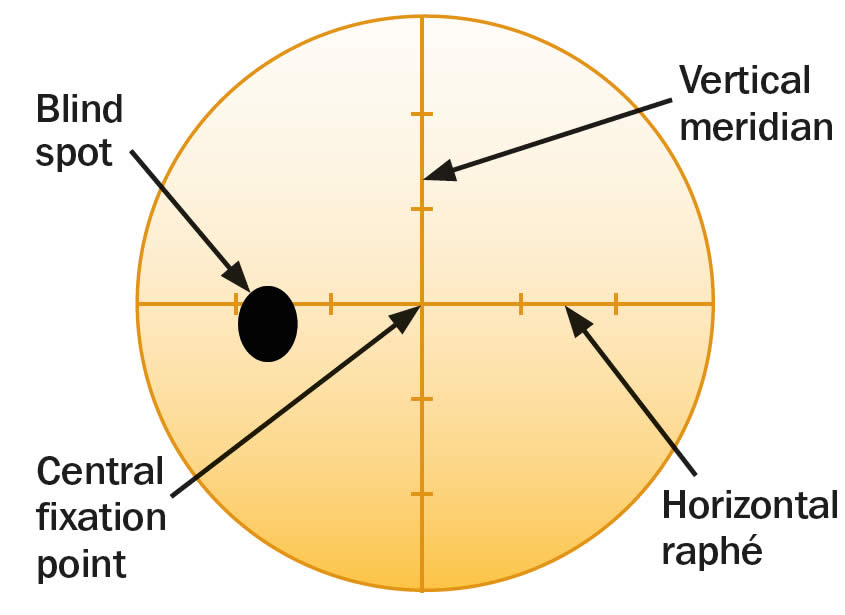*** SCIENCE OF BEING SEEN *** Is the retinal blind spot a problem?
Each of our eyes has a blind spot. This is where, as I’m sure most of you will know, visual information is not detected. These blind areas are due to lack of the specialised photoreceptor rods and cones responsible for capturing light and transmitting visual signals to the brain. The optic nerve carries visual information from the eye to the brain, and the blind spot is caused by the optic nerve’s attachment to the retina where it exits the eye.
The retinal blind spot is a natural feature of the human visual system and covers somewhere between 15 and 20 degrees of our vision in each eye. The diagram shows the approximate location of the blind spot in a healthy left eye. The right eye would be a mirror image.

Recently, I’ve seen a number of articles suggesting that the blind spot is a factor in ‘looked but failed to see’ crashes – or at least, one of the reasons.
One article claimed that cars could go missing in the driver’s retinal blind spot, another suggested that drivers would fail to spot cycles as they approach a junction where the driver is about to turn:
“This blind spot can automatically create problems when driving. If you are not looking and actually moving your head when at junctions for example, you stand the risk of not seeing a narrow object such as a cyclist, because they could be in your blind spot, or even something larger at times.”
The article went on to suggest that “the brain makes up, or fills in what it believes to be there!”
And of course, motorcyclists have read these articles and started reporting on the internet that the retinal blind spots is to blame for collisions where drivers don’t spot motorcycles.
So is the retinal blind spot really a problem?
Almost certainly not. It’s pretty obvious that we don’t have a pair of gaping holes in our visual field, and until we actually try to find them we’re not actually conscious of the presence of the retinal blind spots.
That’s because unless we have lost the sight in one eye, we have binocular vision. That is, the field of vision of each eye overlaps. That means anything in the blind spot of one eye is always going to be within the visual field of the other eye.
As part of the normal processing of visual data, the brain takes the detail and information from both eyes and interpolates – fuses – the images from both eyes into one coherent view.
This means the missing visual data created by the retinal blind spot in one eye is filled in by the brain by using visual data from the other. It’s the same reason we don’t have ‘pigeon vision’ as claimed in a recent FortNine video, and this is why we don’t see our own nose.
Similarly the retinal blind spot is simply not perceived under normal circumstances. In fact, to find the blind spot in one eye, we usually have to cover up the other.
=================================
WHAT IS SCIENCE OF BEING SEEN? (SOBS)
SOBS is my in-depth investigation into the
‘Sorry Mate, I Didn’t See You (SMIDSY) collision
between motorcycles and other vehicles.
It’s based firmly on science, not speculation
and aims to quash some persistent myths
about just why junction collisions happen, and
show motorcyclists there are straightforward
techniques we can employ to stay out of trouble!
FIND OUT MORE – http://www.scienceofbeingseen.org
WATCH OUT FOR LIVE ONLINE TALKS
SUPPORT SOBS at http://www.ko-fi.com/survivalskills
The second point to make is that to make a detail scan of any particular area, we have to look directly at it, to bring it into the narrow cone of clearly focused, colour vision which is right in the centre of the visual field, and just 5 degrees across.
If we look along a road towards oncoming traffic, we examine the scene with our foveal vision. Even if our brain failed to perceive a motorcycle that was in the blind spot of one eye, it would be visible in the other eye since the two retinal blind spots are offset to opposite side.
And it’s even unlikely that the approaching motorcycle would be in the blind spot since, it’s offset to one side and mostly below the ‘horizon’ created by our foveal zone.
So, I’d suggest that for normally sighted people with binocular vision, the retinal blind spot is not a problem.
However, there are a number of diseases and conditions that can cause blind spots or scotomas in the eyes. These blind spots can be temporary or permanent, and they may affect a small portion of the visual field or a larger area, depending on the underlying cause. Some common conditions that can lead to blind spots include:
Glaucoma
Macular degeneration
Optic neuritis
Retinal detachment
In short, regular eye tests are essential for detecting eye problems early, even if you don’t currently have any noticeable symptoms. And should you experience any sudden or persistent vision changes, including the appearance of blind spots, you should seek immediate medical attention.
That’s far better advice than telling motorcyclists drivers don’t see them because of retinal blind spots.